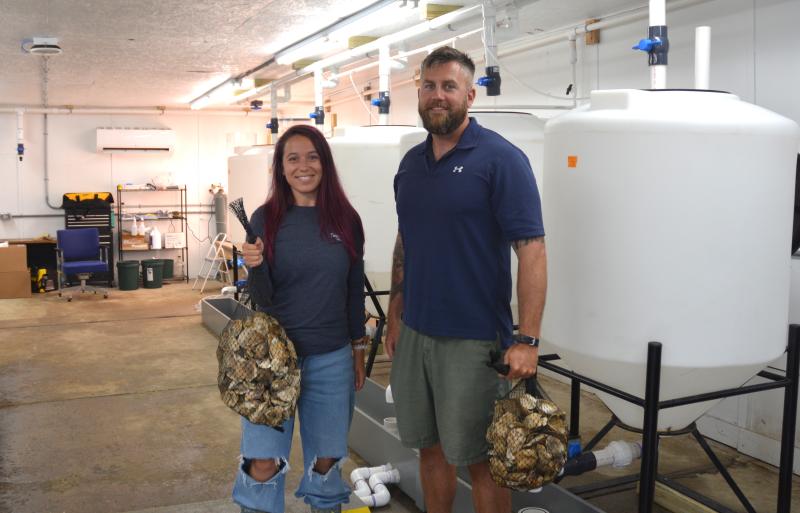Lewes oyster hatchery has successful growing season

From going out to leased aquaculture sites in Rehoboth Bay to sitting through hours-long meetings, I’ve covered the state’s fledgling aquaculture program fairly extensively over the past few years. It’s an interesting subject on a number of different fronts, and I want it to succeed.
I’m not the only one, which is why the University of Delaware, Delaware State University and Delaware Sea Grant have been working together to build out a shellfish hatchery off Pilottown Road in Lewes for the past year or so. A successful hatchery would benefit local aquaculturists in at least two ways – oyster seed, or spat, grown in Delaware is not required to go through the same testing as spat coming from out of state; it will reduce the bottleneck in the supply chain.
I’m happy to report that not only is the hatchery up and running, but also, there are pencil-eraser-sized oysters grown at the hatchery that are now sitting on the bottom of Delaware Bay.
Ed Hale, fisheries and aquaculture extension faculty with Delaware Sea Grant and assistant professor in the University of Delaware’s School of Marine Science and Policy, is one of the university officials overseeing the hatchery.
A couple of days before the interview, the team had bagged up 105,000 oysters into 200 bags and put them into Delaware Bay on privately leased oyster beds. They’ll be left out there to grow for two to three years, said Hale. While the oysters grow, Hale said, there are a few benefits, pointing to cleaning of water and creating habitat for other marine species.
The 105,000 number may sound like a lot, but it’s not.
“We’d love to be making 100 times that amount,” said Hale.
The brood stock came from Rutgers University. Alyssa Campbell, Delaware Sea Grant’s Fisheries and Aquaculture Laboratory coordinator, said the spawning season for the hatchery is limited to what would be found in the wild because the hatchery isn’t fitted with the ability to condition the water. It can be extended by a couple of months, but only so much can be done.
Campbell said they ran the first test spawning in May. By the first week of June, they realized there were oysters growing. Overall, she said, they were able to have eight spawns this year.
“When we realized the oysters were growing, our game faces went on because we knew we’d have to do the work now,” said Campbell.
Looking forward, the plan is to iron out efficiencies and look for ways for the program’s physical space to grow. It’s pretty much capped in terms of size, said Hale.
Hale said he didn’t think the program would be producing anything for two to three years, so he set the bar low, he said.
“I just wanted the plumbing to survive,” he said.
Campbell is equally as optimistic for next year’s spawning season.
“This year’s success sets a very positive outlook. We should be much more confident about next year’s production,” she said.
Land-based farming news
It appears Delaware is on its way to having a successful growing season – at least for corn and soybeans. According to the monthly Agriculture Counts report issued by the U.S. Department of Agriculture’s statistics service for the Northeastern Regional Field Office, overall across the country, corn production is forecast to be up 10% from last year, while soybean production is forecast to be down 2%.
However, in Delaware specifically, the report says corn production is forecast at 33.2 million bushels, up 17% from 2022. Based on conditions as of Aug. 1, yields are forecast to average 193 bushels per acre, up 23.0 bushels from the 2022 average.
The report says soybean production in Delaware is forecast at 7.40 million bushels, up 9% from 2022. Based on Aug. 1 conditions, yield is forecast to average 50.0 bushels per acre, up 7.0 bushels from last year.
Joke of the Week:
I feel like there’s been a lot of news recently about killer whales attacking boats. From a number of different articles I’ve read on the subject, there’s still no real explanation for the attacks. The good news for the boaters here in the Cape Region is that killer whales aren’t anywhere near. As always, send jokes to cflood@capegazette.com.
Dad: There have been over 20 reported killer whale attacks in the month of May. The whales worked in tandem. Do you know what that means?
Son: No.
Dad: It means the attacks were orca-strated.
Chris Flood has been working for the Cape Gazette since early 2014. He currently covers Rehoboth Beach and Henlopen Acres, but has also covered Dewey Beach and the state government. He covers environmental stories, business stories and random stories on subjects he finds interesting, and he also writes a column called Choppin’ Wood that runs every other week. He’s a graduate of the University of Maine and the Landing School of Boat Building & Design.























































